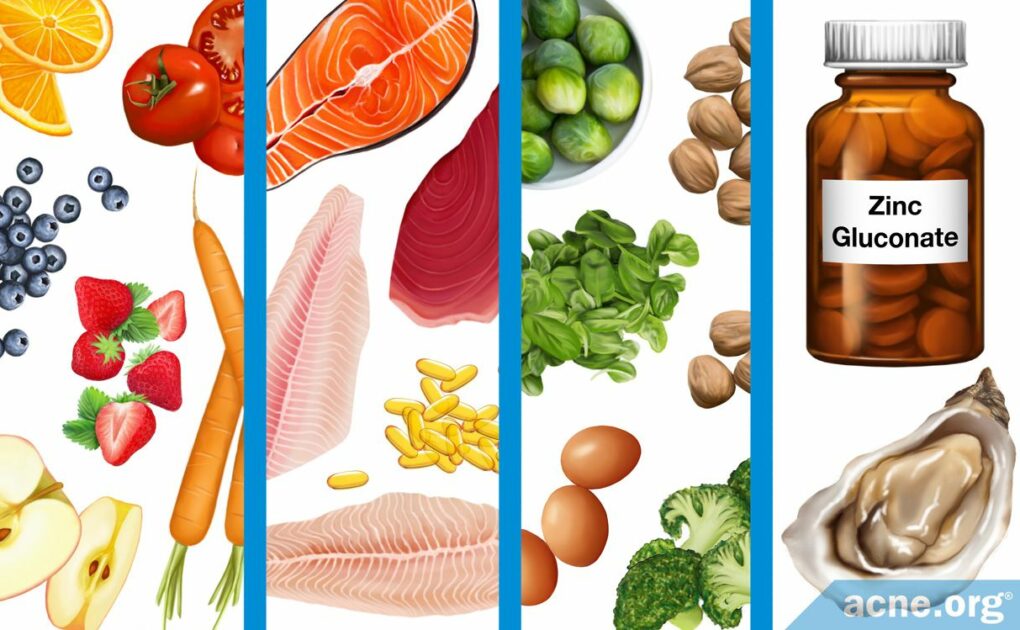Looking at the Research and Possible Links Between Diet and Acne

The Essential Info
Studying the relationship between diet and any disease, including acne, is complex, time-consuming, and expensive. For these reasons, the research performed thus far on diet and acne has relied mainly on surveys, which are less than ideal. However, from the admittedly imperfect data we have, some hints and clues on how to eat are coming into focus, including:
Eating a Low-glycemic Diet: This means eating more whole foods like meat/fish/poultry, eggs, nuts, oils, vegetables, and berries and eating less processed foods like white bread, candy, and soda.
Enjoying Lots of Colorful Vegetables and Fruits: Vegetables and fruits contain antioxidants, which may help calm the skin and keep inflammation in check. Since acne is an inflammatory disease, it’s a good idea to make sure you have the antioxidants you need. Real, colorful vegetables and fruits are the best way to get them. Berries in particular are low glycemic fruits and are packed with antioxidants, so they may be the best fruit choice.
Supplementing with 30 mg of Zinc Per Day: Several studies show a connection between low zinc levels and acne. Supplementing with 30 mg of zinc gluconate per day is an easy way to ensure you have the zinc you need. Fun fact: Oysters contain far more zinc than any other food. Eating just a couple oysters will give you all the zinc you need for that day.
Supplementing with Fish Oil Pills: Taking up to 6 fish oil pills (or up to 3 “concentrated” fish oil pills) will give your body a healthy dose of anti-inflammatory omega-3 fats, which may help combat the inflammatory component of acne.
Drinking Less Milk (?): As more evidence trickles in, from what we can see, it might be a good idea to drink less milk. However, there is no evidence showing that cheese or yogurt affect acne in any way.

The Science
- Dairy and Acne
- Glycemic Index / Glycemic Load
- Caloric Intake
- Chocolate
- Fatty / Oily Foods
- Omega-3
- Zinc
- Iodine
- Antioxidants
- The Gut
- Presentation of bias
Science still does not know whether diet and acne are related, but evidence is mounting that diet may affect acne. Based on what we are seeing in clinical research, it seems prudent to eat a relatively low-glycemic diet rich in colorful fruits and vegetables and omega-3 fats and to perhaps supplement with 30 mg of zinc gluconate per day. However, due to our modern diets and Western style of living, achieving sustainable relief of acne from changes in diet alone remains an elusive goal.
No matter what anti-acne diet you embark upon, while you may see a short-term reduction in acne while your body loses weight, symptoms are likely to return as your weight levels off.
Dairy and Acne
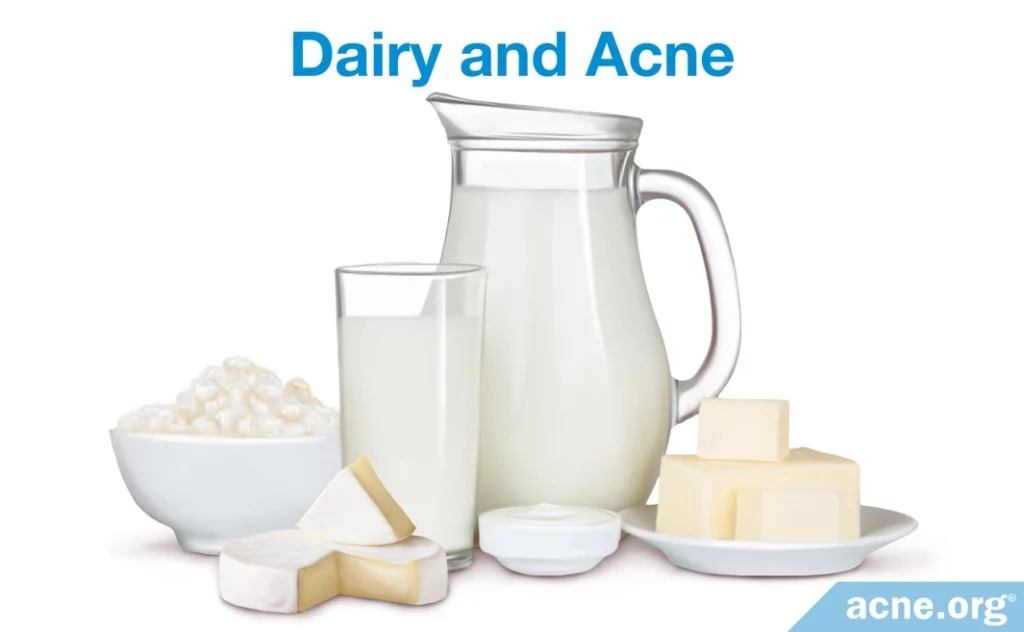
Evidence is mounting that some types of dairy, particularly milk, may have a weak connection to acne.1-3 However, don’t worry about having to eliminate all dairy products from your life. The evidence so far is contradictory, and more research is coming in all the time. At this point, the most you might want to do is consider drinking less milk. Cheese and yogurt show no connection to acne.
It makes common sense based on the hormones present in milk that dairy products could affect acne, but the connection between dairy and acne has proven difficult to nail down.

A group of researchers recently performed a thorough analysis of all studies published on dairy and acne so far, called a systematic review. They published their conclusions in the journal Nutrients in 2018.
The researchers looked at 14 studies on dairy and acne with a grand total of 78,529 participants. Overall, the studies pointed to a weak connection between dairy intake and acne.
However, the researchers noted that there is a publication bias, meaning that scientific journals are more likely to publish a positive finding (a study that found a connection between dairy and acne) than a negative finding (a study that failed to find such a connection). The review authors also noted that many of the studies performed so far have been of low quality and that their methods differed so much as to make any general conclusions difficult. They wrote, “Thus, there is still a knowledge gap with respect to whether dairy intake is causally associated with acne, acne flare, or acne severity and to what extent.”1
Deeper science: milk & hormones
IGF-1: Milk contains insulin-like growth factor (IGF-1).4 IGF-1 is a hormone which helps the body build necessary tissues. Increased levels of IGF-1 result in increased skin oil production. Since overproduction of skin oil is a contributor to acne, some scientists hypothesize that milk, and its IGF-1 component, could potentially lead to increased skin oil production and resulting breakouts.
IGF-1 also stimulates the body to produce cells. Acne is thought to sometimes begin with an overproduction of skin cells inside the pore which causes the pore to become clogged. Thus, some scientists also hypothesize that milk may lead to overproduction of skin cells within pores, causing the pores to become clogged and produce the beginning stages of acne lesions.
Androgens: Milk also contains male hormone (androgen) precursors.4,5 These precursors require enzymes to convert them into actual male hormones in the body, and these enzymes are readily available in the pores of the skin.6 Similar to IGF-1, male hormones have been implicated in increased skin oil production and increased skin cell production.7,8
Milk & iodine
At large doses, iodine can cause what are called acneiform (pronounced “ack-nee-form”, the i is silent) eruptions.1 While unproven, some scientists postulate that the iodine content of milk, due largely to the sterilization of the teats of cows with an iodine solution prior to milking, may also contribute to acne.9,10
Glycemic Index / Glycemic Load
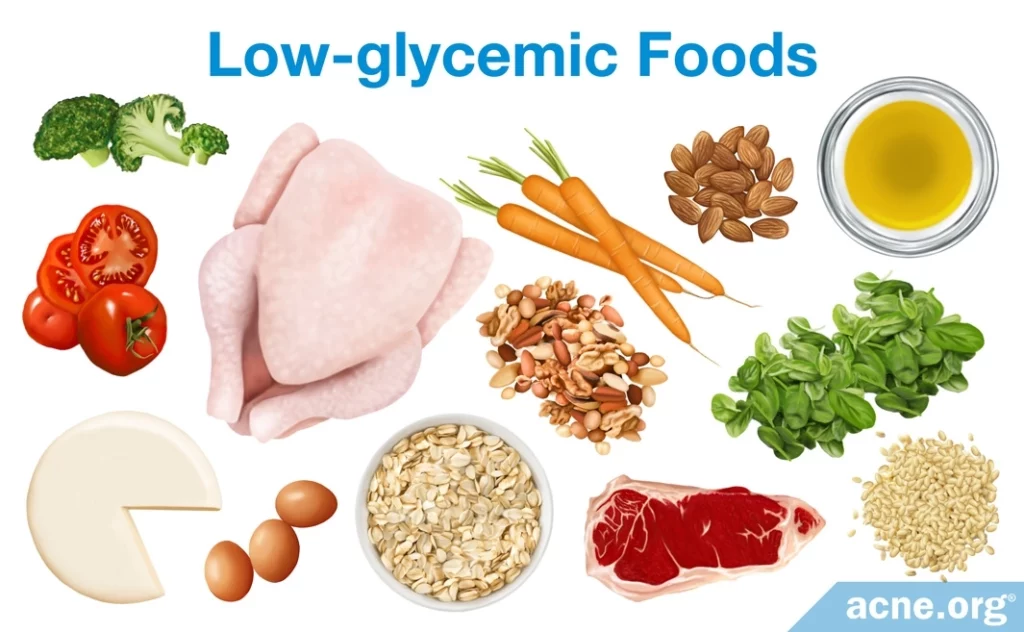
Most studies performed so far show a potential link between consuming a high-glycemic load diet (a diet high in processed foods and sugars) and acne.1-12 This suggests that adopting a low-glycemic load diet may help improve acne. To date, 6 studies seem to bear this out. These studies found that placing volunteers on a low-glycemic diet either reduced acne or at least changed the volunteers’ hormone levels in a way that might lead to improved acne.2-7
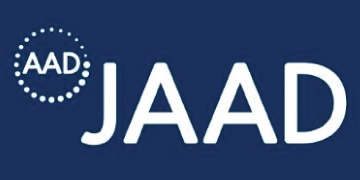
In 2022, a group of researchers conducted a thorough review of 34 studies on diet and acne and also came to the conclusion that a low-glycemic diet might help with acne. As they wrote in the journal JAAD International, “Based on this evidence, we concluded that despite conflicting articles, high-GI (glycemic index) and increased-glycemic content diets can exacerbate [acne] and acne severity, whereas the adoption of a low-GI diet may benefit [acne], decrease the number of lesions, and alleviate acne severity, irrespective of the geographic region or country.”13
All of this sounds great, but at this time, we do not know if low-glycemic diets reduce acne symptoms based on the glycemic load of the foods eaten, or simply based on the accompanying weight loss of such diets.1 We will need better-designed studies to determine whether a low-glycemic diet is better than any other type of diet when it comes to acne.14 At the moment, there is no sense in rushing to adopt a strict low-glycemic diet. However, eating less sugar and less processed food is healthier in general, so it wouldn’t hurt to eat this way when you can.
What does the glycemic index refer to? The glycemic index compares different foods, giving them a numerical ranking, based on how quickly they spike blood glucose levels (the time it takes for the blood sugar to rise when you eat that food).
What does glycemic load mean? The glycemic load takes the glycemic index one step further by calculating how much the blood sugar level rises when you eat a particular quantity of that food (the degree to which the blood sugar rises when you eat that food).
Deeper science: glycemic diet & hormones
Eating lots of high glycemic foods (i.e. sugar, white bread, white potatoes, white rice) which are prevalent in modern diets cause people to live with chronically elevated insulin levels. These chronically elevated insulin levels may lead to problems with:
IGF-1: Increased blood insulin levels lead to increases in insulin-like growth factor (IGF-1), a hormone in our bodies which promotes increased cell growth. Scientists hypothesize that this could lead to an overgrowth of cells inside pores and/or an increase in skin oil production, which could cause pores to become clogged, leading to acne.7,15-19 Scientists also hypothesize that high IGF-1 levels could lead to increased sebum (skin oil) production which may lead to breakouts.
IGFBP-3: Chronically elevated insulin levels lower the amount of insulin-like growth factor binding-protein 3 (IGFBP-3) in the blood. IGFBP-3 regulates IGF-1 and keeps it in check by preventing IGF-1 from binding to its cellular receptor. So, lower amounts of IGFBP-3 means even higher IGF-1 levels. As we have discussed, scientists postulate that increased IGF-1 may lead to overgrowth of cells inside pores.7,15,16 A second way that low levels of IGFBP-3 may potentially affect acne is through lowering the effectiveness of the natural retinoids in the skin. These retinoids prevent cell overgrowth. When IGFBP-3 is low, these retinoids can’t do the work they are made to do.20-26
Androgens: Insulin acts as a “master” hormone. Increased insulin levels raise androgen (male hormone) levels. Increased androgen levels are well-known for their effect on stimulating sebum production, which can lead to more severe acne symptoms.24,25
mTORC1 and Fox01 proteins: Could our Western, high glycemic diet be suppressing and/or over-activating cell proteins which in turn unbalance hormones and increase skin oil production, leading to acne? Scientists are discussing it.18,27-30
Caloric Intake

If in fact lower calories help with acne symptoms, this may be why almost any “acne diet” appears to work. When we remove foods from our diet and do not replace them with others, we are eating less calories, and thus losing weight. It is important that scientists flesh this out. Until then, we cannot say whether any acne diet is working based on the content of what is eaten or simply the overall calories. An article in the Journal of the Academy of Nutrition and Dietetics puts it well:

“These gaps in the literature should not intimidate but rather challenge dermatologists and registered dietitians to work collaboratively to design and conduct quality research.”1
Can increased calories cause acne?
The argument for: Increased calories result in higher male hormone (androgen) levels. Higher androgen levels can lead to skin cell growth and increased skin oil (sebum) output. Skin cell overgrowth may clog pores, leading to acne formation, and increased skin oil may lead to worsening of acne symptoms.
Doctors have noted that in famine-hit parts of the world, starvation-level calories result in dramatic reduction in skin oil production and a complete halting of acne symptoms.2,3 This is obviously not a sustainable way to treat acne. However, even when exposed to a moderate calorie deficit, the body becomes insulin-sensitive. Insulin is a master hormone, and insulin sensitivity lowers levels of insulin (this is because your body needs less insulin to do the same job since it is more sensitive to the hormone). This results in a hormonal cascade which theoretically would help prevent pores from becoming clogged and help the skin produce less oil. After a period of lowered calories, however, when calories resume to a maintenance level, this could also theoretically lead to an acne symptom recurrence. Therefore, it is more important, and practical, to focus on the quality of calories (by cutting down on junk foods and increasing the proportion of colorful fruits and vegetables in our diet), rather than their quantity.
Increased body mass (BMI) was found to be correlated with acne in one study of young males.4 In another study, no significant correlation was found in young men, but a significant correlation was found amongst young women.5 Recently, another study showed a positive correlation between acne and BMI in both young males and females.6
Obesity is correlated with other skin diseases such as psoriasis.5
The argument against: From three studies, obesity and body mass index do not appear correlated with acne.7-9
Chocolate
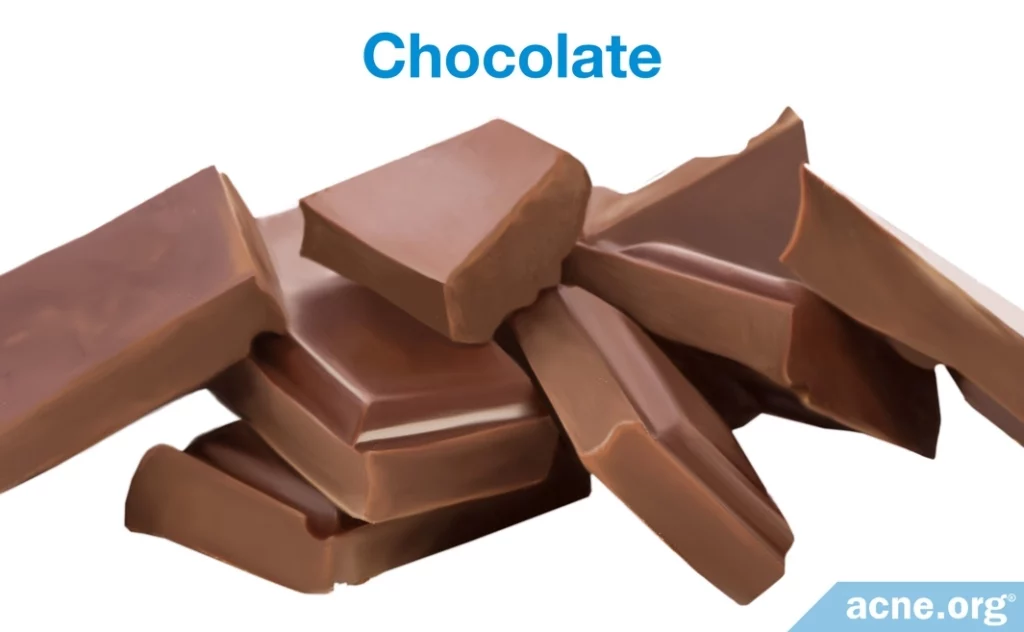
Over the last dozen years, studies have come in showing a weak connection between eating chocolate and increased acne. Although each study had limitations, taken together, the studies do suggest that overindulging in chocolate might be a bad idea for acne-prone people.
However, this does not mean you need to ban all chocolate from your life. While there may be a correlation between chocolate and acne, singling out any food as an acne villain is likely to be a wild goose chase. The combined stress involved in nervously avoiding chocolate and other perceived “bad” foods may itself lead to stress-induced acne. Instead, aim to consume chocolate in moderation, keeping in mind that overdoing it might contribute to acne.
History of the debate
For decades in the early 20th century, doctors and medical texts warned acne-prone people to avoid chocolate. This advice was put to the test with two studies in 1969 and 1971.1,2 Both studies showed no correlation with chocolate intake and acne. However, these studies were small, uncontrolled, short-duration, subjective, included very short follow-up, and employed inadequate statistical analysis. They also did not account for the sugar or dairy content of chocolate being ingested. Despite the severe design limitations inherent in these chocolate-specific studies, not only did the dermatology community dismiss the possible chocolate/acne correlation, but also sent out the message that diet and acne are not related. This massive overstating of flawed evidence is a historic and staggering error of the entire dermatology community.
However, as time has moved on, modern scientists have started putting diet, and along with it, chocolate, back under consideration. Since 2011, 10 new studies have demonstrated a weak relationship between chocolate consumption and acne.3-12 Since studying how any one factor in the diet affects acne is notoriously difficult, each study had limitations that make it impossible to draw firm conclusions. Still, the fact that all 10 studies point to a connection between high chocolate intake and acne suggests there may be something to it.
Deeper science: chocolate & insulin
A 2003 study showed insulin levels raised after meals which included chocolate, especially chocolate mixed with milk (chocolate milk) in lean young adults.13 While it is certainly too soon to draw conclusions, this could theoretically be the result of the active compounds in chocolate spiking insulin levels and/or the combination of the amino acids in chocolate mixed with carbohydrates and causing an insulin spike. If elevated insulin does in fact increase skin cell production and/or sebum (skin oil) production, this could clog pores and provide a breeding ground for acne bacteria. Therefore, chocolate could theoretically be part of this insulin cascade and resulting acne symptoms.
Deeper science: chocolate & protein signaling
Scientists have uncovered a small amount of evidence pointing toward chocolate perhaps increasing IL-10 protein production.14 Might this, or something else entirely such as the unique effects of the monounsaturated and saturated fats in cocoa butter contribute to acne?15 Even milk, which is found in a lot of chocolate, might be a suspect. In other words, we really don’t know which components of chocolate, if any, might play a role in worsening acne.
Beneficial effects of chocolate
On the other hand, chocolate contains antioxidants, which could theoretically help with acne symptoms.
Dark chocolate may actually reduce blood pressure as well. Might reduced blood pressure in some way promote oxygen and nutrient distribution to the dermis, thus preventing acne in some marginal way?15
Fatty / Oily Foods

Fat is needed for our overall health and well-being. However, whether saturated, unsaturated, and/or hydrogenated fats affect acne remains unknown.
Out of 5 questionnaire-based studies, 3 have found that people with acne tend to eat more fatty foods than people without acne. (The other 2 studies found no difference in fat consumption between people with and without acne.)1-5 This might suggest that fatty foods somehow increase acne, but the evidence is far too weak to jump to this conclusion. The studies had many uncontrolled factors, including other differences in diet between people with and without acne, such as how much chocolate and sugar they consumed. In other words, we have no idea whether fat is really the culprit or even an accomplice in triggering acne.
Current evidence does show that the fat we eat is in fact used to make skin oil (sebum). In addition, at least 1 study has shown that fatty diets lead to higher fat content in sebum.6 The evidence stops there. Whether more fat in sebum leads toward increased or decreased acne symptoms is up for debate. Scientists are looking into the nature of sebum, particularly its saturated or unsaturated content, to see if they can find clues to acne development.
Omega-3
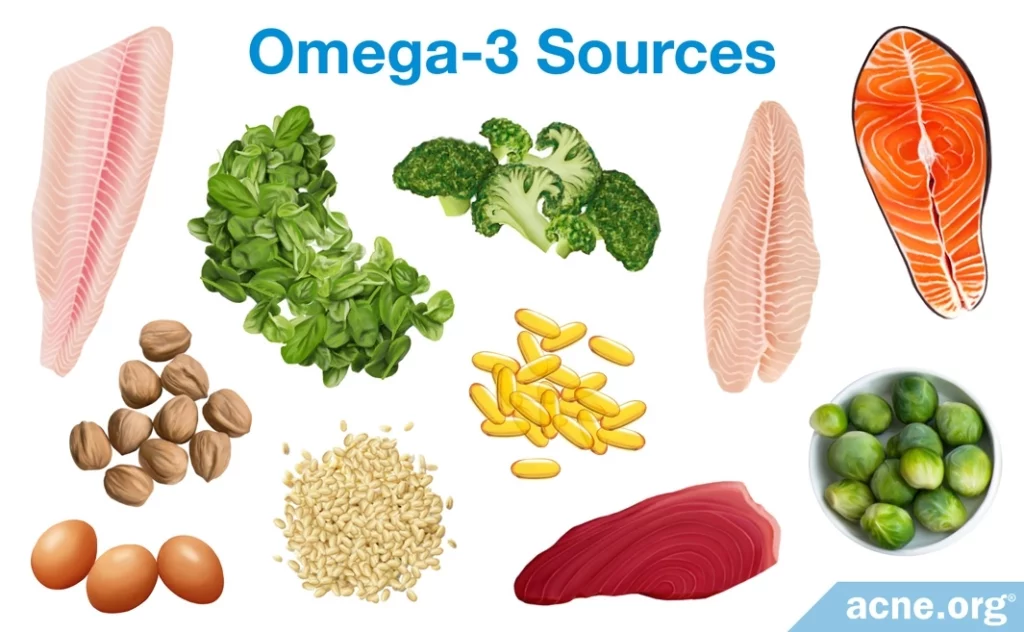
Most people living in modernized societies eat far more Omega-6 fats from foods such as grains, vegetable oils, nuts, and poultry than they do Omega-3 fats from foods such as fish and fish oils, grass-fed meat, seeds such as flax seeds and chia seeds, and hemp.1 This is in stark contrast to hunter/gatherer societies and to what our ancestors evolved to eat. Eating a more balanced ratio of Omega-3:Omega-6 fats can help modulate inflammation in the human body.2 Since acne is an inflammatory disease, it makes sense that anything that can reduce inflammation would also help reduce acne.
Omega-3s & Inflammation
Omega-3 fats, especially the omega-3 fatty acids from EPA and DHA commonly found in cold-water fish, work by reducing the production of inflammatory cytokines3,4 and inflammatory leukotriene B4 molecules.5 EPA and DHA also inhibits mTORC1, a protein which can signal skin oil glands to produce more oil.6-8
Omega-3s & Stress
Omega-3s are known to improve mood and reduce stress and anxiety.9 Since stress and acne are linked,10 this is another way omega-3 fats could theoretically help reduce acne symptoms.
Omega-3s & Bacteria
EPA in particular is antibacterial11 and along with other fatty acids can inhibit the growth of acne bacteria (C. acnes) as well as S. aureus bacteria, both of which have been associated with acne.12
Omega-3s & Hormones
Omega-3s also help keep IGF-1 (insulin-like growth factor) levels in check,3 which theoretically could help keep the skin from overproducing skin cells, and skin oil thus preventing breakouts.
Omega-3 Studies
Korean researchers in 1 study demonstrated that taking 2000mg EPA + DHA alongside 400mg of gamma-linoleic acid, a type of omega-6 fatty acid, significantly reduced inflammation and acne.13
In addition, 1 case report described 5 patients with acne who took an omega-3 supplement for 2 months. Four of these 5 patients experienced a reduction in acne lesions. However, the supplement contained other ingredients besides omega-3s that might have helped with acne.14
More studies attempting to link Omega-3 intake and acne are needed.
Zinc
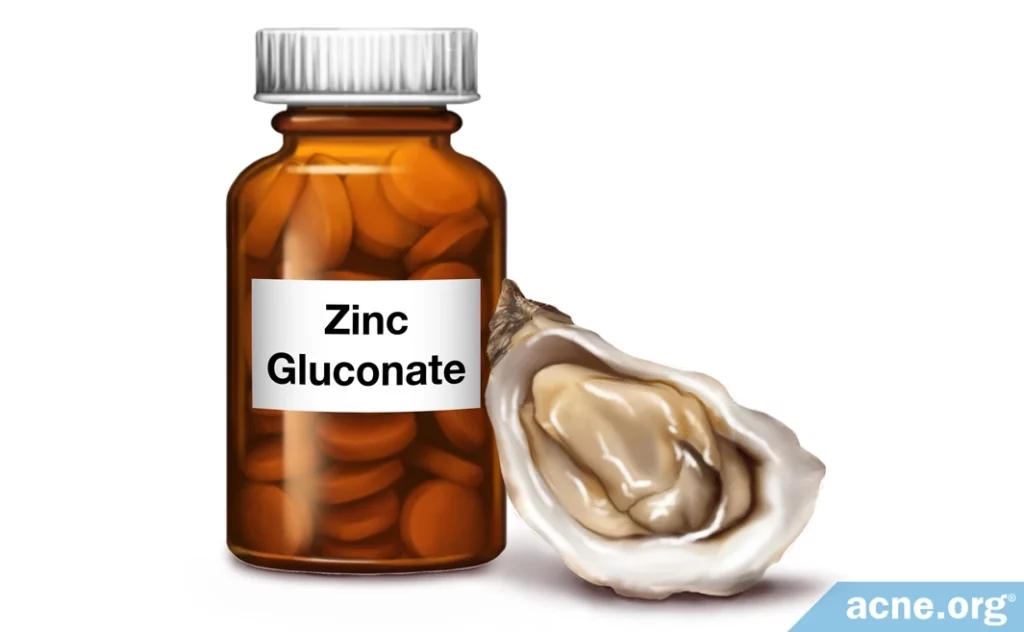
As far as supplementation goes, zinc stands alone with the most evidence pointing toward a beneficial effect on acne, however moderate that effect may be. Over-the-counter zinc supplements normally come in 30 – 50 mg tablets. The National Institutes of Health put tolerable levels of zinc for adults (19 years and above) at 40 mg a day.1 Zinc gluconate may be a better choice than zinc sulfate due to its superior bioavailability. Since meat and poultry provide the majority of zinc in Western diets, vegetarians may want to take special care to ensure they are ingesting adequate amounts of zinc.
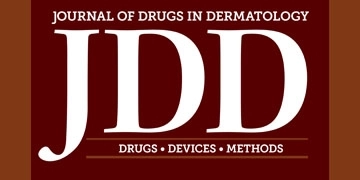
A systematic review of medical literature in the Journal of Drugs in Dermatology concludes, “The preponderance of evidence suggests zinc has anti-bacterial and anti-inflammatory effects and that it may decrease sebum production.”2
Six percent of our body’s supply of zinc is in our skin,3 and after years of study and quite a bit of evidence, it appears that zinc supplementation may help with acne symptoms.
How zinc works
Zinc helps maintain skin integrity, reduces inflammation, promotes wound healing, helps kill and suppress acne bacteria, and may reduce skin oil production.13-17
Getting zinc naturally
A variety of foods contain zinc. Oysters contain about 5X that of the Daily Value (DV) of zinc (which is the recommended daily intake of zinc through natural foods). Eating 2 ounces (about 4 oysters), twice a week, is a fun way to get 100 mg of zinc per week.
Zinc studies
Multiple studies have been performed on people with acne who are administered oral zinc supplementation.4-7 Overall results show a reduction in acne lesion count above that of placebo, albeit only moderately.8,9 The dosage of zinc in these studies is normally quite high,10 and more studies are needed to see if the reduction in acne symptoms could be sustained at lower levels of zinc. However, since other studies show lower blood zinc levels in people with acne,11,12 keeping zinc levels up to par is a compelling option. The Recommended Daily Allowance (RDA) of zinc in adults (19 years and above) is 11 mg (which includes supplements and the food we consume).
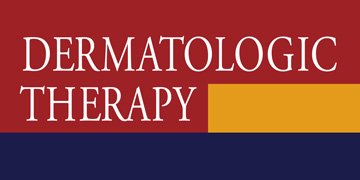
A group of researchers who combed through 25 studies in 2020 echoed this conclusion. As they wrote in the journal Dermatologic Therapy, ”Acne patients have decreased serum zinc levels. Zinc is effective for the treatment of acne, particularly at decreasing the number of inflammatory papules.”18
Iodine
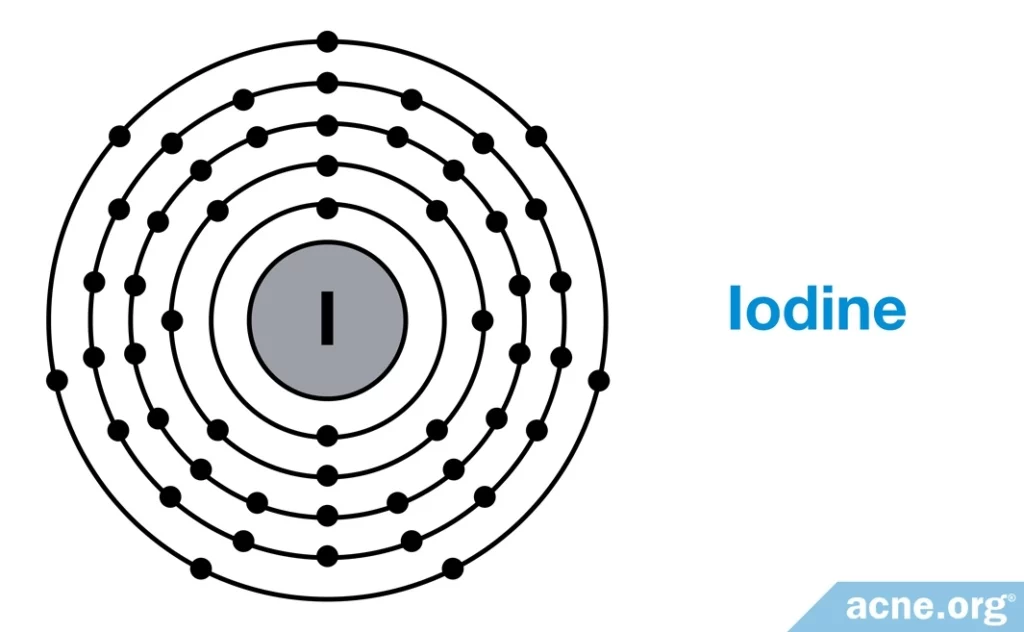
There is no evidence that typical amounts of iodine obtained from food and iodized salt have any effect on acne.1-3
High levels of iodine have been shown to elicit what are called acneiform eruptions. These eruptions are different from run-of-the-mill acne and are evidenced by a quick onset, wide distribution on the body, and inflammatory (raised, red lesions) outbreaks. To prevent this side effect, avoid taking iodine or kelp supplements and don’t binge on kelp or seaweed.4
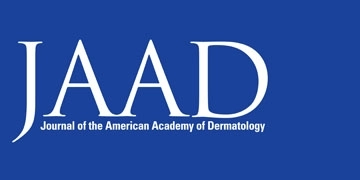
According to an overview of the latest evidence regarding diet and acne published in the Journal of the American Academy of Dermatology, “Iodine has been implicated as a cause of acne vulgaris, however, no literature to date supports iodine as a culprit in comedonal acne.”5
Iodine studies
The evidence is sparse. It appears that consuming very high levels of iodine containing kelp and iodine containing drugs can cause acneiform eruptions.2,6 However, in one study from 1961, people who ate a lot of seafood and fish, a food group which contains high levels of iodine, were shown to actually have lower levels of acne.1 Other studies have shown no correlation between fish/seafood and acne.
Antioxidants
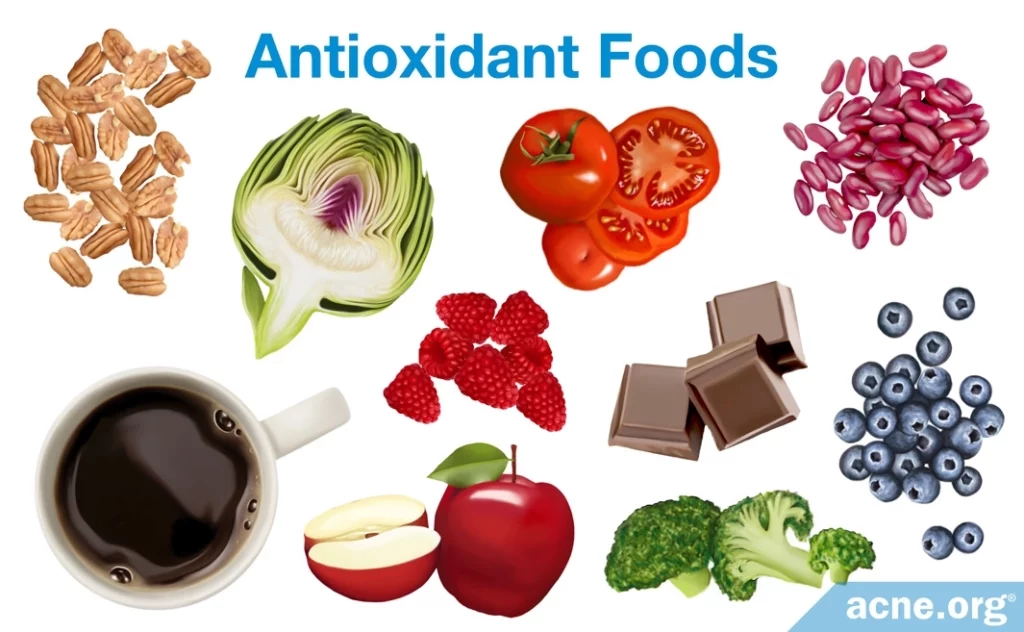
Eating a diet rich in colorful fruits and vegetables will help your overall health and may or may not help reduce the inflammation inherent in the acne process. When it comes to taking antioxidant supplements, zinc is the one with the most evidence behind it (see above).
Acne is partly an inflammatory disease. The inflammatory process is what causes acne affected pores to become characteristically inflamed and red. Antioxidants in the body help resolve this inflammatory response.
The evidence
People with acne tend to have less antioxidants, such as vitamin A, vitamin E, and selenium, in their skin.1-3 It makes common sense that bringing antioxidant levels up to par would help calm the inflammatory response. However, we do not have enough evidence at this point to definitively say whether or not antioxidants in food or supplements help with acne. Topical antioxidants on the other hand, have shown promise in reducing acne lesion count. Examples of topical antioxidants include green tea, resveratrol, and licochalcone.
The Gut
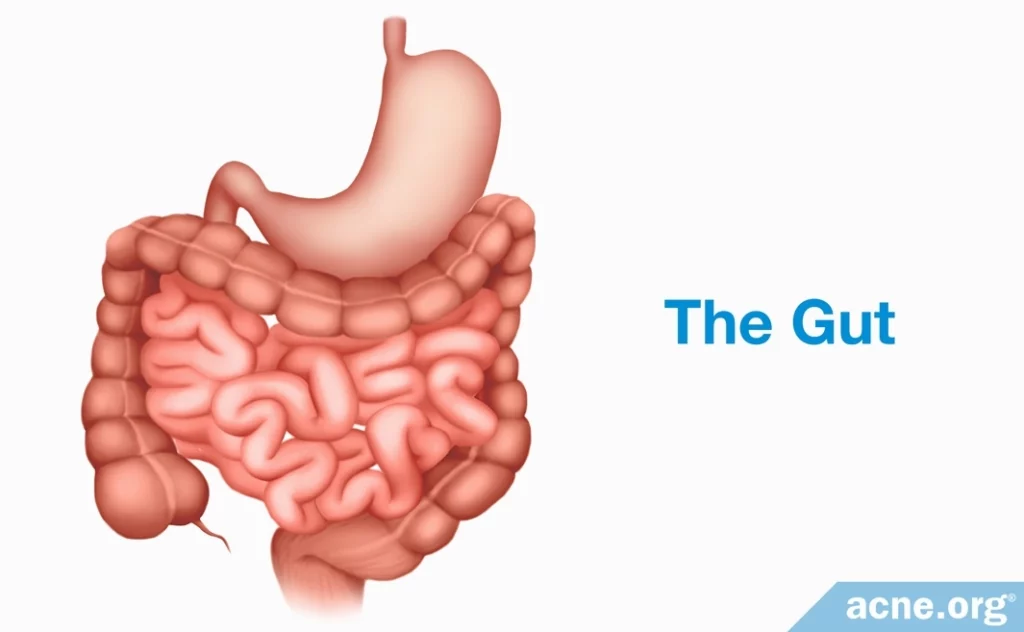
According to the theory of the so-called gut-brain-skin axis, the balance of beneficial bacteria living in the gut may be important for maintaining healthy skin. Scientists speculate that a lack of beneficial gut bacteria might make a person more prone to acne breakouts.1 Lending indirect support to this idea, acne rosacea (AKA rosacea), a disease which presents somewhat similar symptoms to acne vulgaris (run-of-the-mill acne), tends to show a strong correlation with intestinal issues, including bacteria overgrowth.
Acne vulgaris is not the same disease as acne rosacea, and intestinal discomfort is not as common amongst acne vulgaris sufferers. However, the possible connection between gut bacteria and acne is an active area of research. Would a high fiber diet help with acne? What about probiotics?
The evidence
Currently, there is limited evidence on the relationship between gut bacteria and acne vulgaris. Some studies have shown that consuming probiotics leads to an improvement in acne symptoms.2-5 The proposed theory for this effect is that probiotics help to maintain the balance of bacteria in the gut, which helps to decrease systemic inflammation, which in turn may reduce inflammation and oil production in the skin. However, further research is required to confirm a definite relationship between gut bacteria and acne, and whether taking probiotics would be beneficial.
Presentation of bias
“As a critical sociology major in college, I learned that it is important for an author to present their bias. Because we are human and it is impossible to be completely unbiased, the presentation of bias allows the reader to take the author’s bias into account when absorbing content.
My bias: Throughout my adolescence and early adulthood, I read in various places that chocolate and sugar were bad for acne. I carefully avoided chocolate and sweets for years, which did not end up helping with my acne, but did harm social interactions. I finally gave up on eliminating so-called “bad” foods from my diet, and my acne did not change considerably. Years later, after I had already discovered The Regimen and cleared up, I decided to attempt to clear my skin from the inside out by eating strictly paleo, which means eating a “caveman diet” consisting of only foods that were available before the advent of agriculture. I stopped The Regimen and instead began eating only vegetables, fruit, tubers (potatoes, yams, sweet potatoes), nuts, seeds, and meat. I completely eliminated sugar, added salt, grains, legumes (beans), and dairy. The diet seemed to work during the first month or so. However, during this first month I was also losing weight from eating in such a clean way. About six weeks into the diet, as soon as my weight leveled off, the acne returned. My conclusion, drawn from personal experience, was that no matter how cleanly I ate, it was not enough to stay clear. I slowly returned to a modern style of eating, but still try to remain aware of my glycemic load and also try to eat lots of colorful fruits and vegetables and take 5 or 6 fish oil pills and a 30mg zinc pill most days. My common sense tells me that eating sugar and high glycemic processed food can’t be a good thing for my overall health or the health of my skin.”
Dan Kern, Acne.org founder
References
Dairy and Acne
- Juhl, C. R., Bergholdt, H. K. M., Miller, I. M., Jemec, G. B. E., Kanters, J. K. & Ellervik, C. Dairy intake and acne vulgaris: A systematic review and meta-analysis of 78,529 children, adolescents, and young adults. Nutrients. 10, 1049 (2018). https://pubmed.ncbi.nlm.nih.gov/30096883/
- Aghasi, M., Golzarand, M., Shab-Bidar, S., Aminianfar, A., Omidian, M. & Taheri, F. Dairy intake and acne development: A meta-analysis of observational studies. Clin. Nutr. 38, 1067-1075 (2019). https://www.ncbi.nlm.nih.gov/pubmed/29778512
- Heng, A. H. S. & Chew, F. T. Systematic review of the epidemiology of acne vulgaris. Sci. Rep. 10, 5754 (2020). https://www.ncbi.nlm.nih.gov/pubmed/32238884
- Koldovsky, O. Hormones in milk. Vitam. Horm. 50, 77 – 149 (1995). https://www.ncbi.nlm.nih.gov/pubmed/7709605
- Danby, F. W. Acne and milk, the diet myth, and beyond. J. Am. Acad. Dermatol. 52, 360 – 362 (2005). https://www.ncbi.nlm.nih.gov/pubmed/15692488
- Chen, W., Thiboutot, D. & Zouboulis, C. C. Cutaneous androgen metabolism: basic research and clinical perspectives. J. Invest. Dermatol. 119, 992 – 1007 (2002). https://www.ncbi.nlm.nih.gov/pubmed/12445184
- Adebamowo, C. A. et al. High school dietary dairy intake and teenage acne. J. Am. Acad. Dermatol. 52, 207 – 214 (2005). https://www.ncbi.nlm.nih.gov/pubmed/15692464
- Adebamowo, C. A. et al. Milk consumption and acne in teenaged boys. J. Am. Acad. Dermatol. 58, 787 – 793 (2008). https://www.ncbi.nlm.nih.gov/pubmed/18194824
- Bowe, W. P., Joshi, S. S. & Shalita, A. R. Diet and acne. J. Am. Acad. Dermatol. 63, 124 – 141 (2010). https://www.ncbi.nlm.nih.gov/pubmed/20338665
- Hitch, J. M. Acneform eruptions induced by drugs and chemicals. JAMA 200, 879 – 880 (1967). https://www.ncbi.nlm.nih.gov/pubmed/4225865
Glycemic index / Glycemic load
- Bronsnick, T., Murzaku, E. C. & Rao, B. K. Diet in dermatology: Part I. Atopic dermatitis, acne, and nonmelanoma skin cancer. J. Am. Acad. Dermatol. 71, 1039 (2014). https://www.ncbi.nlm.nih.gov/pubmed/25454036
- Zaenglein, A. L. et al. Guidelines of care for the management of acne vulgaris. J. Am. Acad. Dermatol. 74, 945-973 (2013). https://www.ncbi.nlm.nih.gov/pubmed/26897386
- Smith, R. N., Mann, N. J., Braue, A., Makelainen, H. & Varigos, G. A. A low-glycemic-load diet improves symptoms in acne vulgaris patients: A randomized controlled trial. Am. J. Clin. Nutr. 86, 107-115 (2007). https://www.ncbi.nlm.nih.gov/pubmed/17616769
- Smith, R. N., Mann, N. J., Braue, A., Makelainen, H. & Varigos, G. A. A low-glycemic-load-diet versus a conventional, high-glycemic-load diet on biochemical parameters associated with acne vulgaris: A randomized investigator-masked, controlled trials. J. Am. Acad. Dermatol. 57, 247-256 (2007). https://www.ncbi.nlm.nih.gov/pubmed/17448569
- Smith, R. N., Braue, A., Varigos, G. A. & Mann, N. J. The effect of a low glycemic load diet on acne vulgaris and the fatty acid composition of skin surface triglycerides. J. Dermatol. Sci. 50, 41 – 52 (2008). https://www.ncbi.nlm.nih.gov/pubmed/18178063
- Smith, R. N., et al. A pilot study to determine the short-term effects of a low glycemic load diet on hormonal markers of acne: A nonrandomized, parallel, controlled feeding trial. Mol. Nutr. Food Res. 52, 718-726 (2008). https://www.ncbi.nlm.nih.gov/pubmed/18496812
- Burris, J., Shikany, J. M., Rietkerk, W. & Woolf, K. A Low glycemic index and glycemic load diet decreases Insulin-like Growth Factor-1 among adults with moderate and severe acne: A short-duration, 2-week randomized controlled trial. J Acad Nutr Diet. 118, 1874-1885 (2018). https://pubmed.ncbi.nlm.nih.gov/29691143/
- Ismail, N. H., Manaf, Z. A. & Azizan, N. Z. High glycemic load diet, milk and ice cream consumption are related to acne vulgaris in Malaysian young adults: a case control study. BMC Dermatol. 12, 13 (2012). https://www.ncbi.nlm.nih.gov/pubmed/22898209
- Çerman, A. A., Aktaş, E., Altunay, İ. K., Arıcı, J. E., Tulunay, A. & Ozturk, F. Y. Dietary glycemic factors, insulin resistance, and adiponectin levels in acne vulgaris. J. Am. Acad. Dermatol. 75, 155-162 (2016). https://www.ncbi.nlm.nih.gov/pubmed/27061046
- Burris, J., Rietkerk, W., Shikany, J. M. & Woolf, K. Differences in dietary glycemic load and hormones in New York City adults with no and moderate/severe acne. J. Acad. Nutr Diet. 117, 1375-1383 (2017). https://www.ncbi.nlm.nih.gov/pubmed/28606553
- Reynolds, R. C. et al. Effect of the glycemic index of carbohydrates on acne vulgaris. Nutrients. 2, 1060-1072 (2010). https://www.ncbi.nlm.nih.gov/pubmed/22253996
- Pavithra, G., Upadya, G. M. & Rukmini, M. S. A randomized controlled trial of topical benzoyl peroxide 2.5% gel with a low glycemic load diet versus topical benzoyl peroxide 2.5% gel with a normal diet in acne (grades 1-3). Indian J. Dermatol. Venereol. Leprol. 85, 486-490 (2019). https://www.ncbi.nlm.nih.gov/pubmed/30264745
- Meixiong, J., Ricco, C., Vasavda, C. & Ho, B. K. Diet and acne: A systematic review. JAAD Int. 7, 95-112 (2022). https://pubmed.ncbi.nlm.nih.gov/35373155/
- Kucharska, A., Szmurło, A. & Sińska, B. Significance of diet in treated and untreated acne vulgaris. Postepy Dermatol Alergol. 33, 81-86 (2016). https://pubmed.ncbi.nlm.nih.gov/27279815/
- Nam, S. Y. et al. Effect of obesity on total and free insulin-like growth factor (IGF)-1, and their relationship to IGF-binding protein (BP)-1, IGFBP-2, IGFBP-3, insulin, and growth hormone. Int. J. Obes. Relat. Metab. Disord. 21, 355 – 359 (1997). https://www.ncbi.nlm.nih.gov/pubmed/9152736
- Brismar, K., Fernqvist-Forbes, E., Wahren, J. & Hall, K. Effect of insulin on the hepatic production of insulin-like growth factor-binding protein-1 (IGFBP-1), IGFBP-3, and IGF-I in insulin-dependent diabetes. J. Clin. Endocrinol. Metab. 79, 872 – 878 (1994). https://www.ncbi.nlm.nih.gov/pubmed/7521354
- Evans, T. R. & Kaye, S. B. Retinoids: present role and future potential. Br. J. Cancer 80, 1 – 8 (1999). https://www.ncbi.nlm.nih.gov/pubmed/10389969
- Kumari, R. & Thappa, D. M. Role of insulin resistance and diet in acne. Indian J. Dermatol. Venereol. Leprol. 79, 291 – 299 (2013). https://www.ncbi.nlm.nih.gov/pubmed/23619434
- Melnik, B. C. & Zouboulis, C. C. Potential role of FoxO1 and mTORC1 in the pathogenesis of Western diet-induced acne. Exp. Dermatol. 22, 311 – 315 (2013). https://www.ncbi.nlm.nih.gov/pubmed/23614736
- Del Prete, M. et al. Insulin resistance and acne: a new risk factor for men? Endocrine 42, 555 – 560 (2012). https://www.ncbi.nlm.nih.gov/pubmed/22447309
- Attia, N. et al. The metabolic syndrome and insulin-like growth factor I regulation in adolescent obesity. J. Clin. Endocrinol. Metab. 83, 1467 – 1471 (1998). https://pubmed.ncbi.nlm.nih.gov/9589640/
- Yang, Q. et al. Biallelic inactivation of retinoic acid receptor beta2 gene by epigenetic change in breast cancer. Am. J. Pathol. 158, 299 – 303 (2001). https://www.ncbi.nlm.nih.gov/pubmed/11141504
- Liu, B. et al. Direct functional interactions between insulin-like growth factor-binding protein-3 and retinoid X receptor-alpha regulate transcriptional signaling and apoptosis. J. Biol. Chem. 275, 33607 – 33613 (2000). https://www.ncbi.nlm.nih.gov/pubmed/10874028
- Wendling, O., Chambon, P. & Mark, M. Retinoid X receptors are essential for early mouse development and placentogenesis. Proc. Natl. Acad. Sci. USA 96, 547 – 551 (1999). https://www.ncbi.nlm.nih.gov/pmc/articles/PMC15173/
- Chiba, H., Clifford, J., Metzger, D. & Chambon, P. Distinct retinoid X receptor-retinoic acid receptor heterodimers are differentially involved in the control of expression of retinoid target genes in F9 embryonal carcinoma cells. Mol. Cell Biol. 17, 3013 – 3020 (1997). https://www.ncbi.nlm.nih.gov/pubmed/9154799
- Grimberg, A. & Cohen, P. Role of insulin-like growth factors and their binding proteins in growth control and carcinogenesis. J. Cell Physiol. 183, 1 – 9 (2000). https://www.ncbi.nlm.nih.gov/pubmed/10699960
- Thacher, S. M., Vasudevan, J. & Chandraratna, R. A. Therapeutic applications for ligands of retinoid receptors. Curr. Pharm. Des. 6, 25 – 58 (2000). https://www.ncbi.nlm.nih.gov/pubmed/10637371
- Eichenfield, L. F. & Leyden, J. J. Acne: current concepts of pathogenesis and approach to rational treatment. Pediatrician 18, 218 – 223 (1991). https://europepmc.org/abstract/med/1835004
- Thiboutot, D. M. Acne. An overview of clinical research findings. Dermatol. Clin. 15, 97 – 109 (1997). https://www.ncbi.nlm.nih.gov/pubmed/9001864
- Danby, F. W. Turning acne on/off via mTORC1. Exp. Dermatol. 22, 505-506 (2013). https://www.ncbi.nlm.nih.gov/pubmed/23800069
- Melnic, B. C., John, S. M., Plewig, G. Acne: risk indicator for increased body mass index and insulin resistance. Acta Derm. Venereol. 93, 644-649 (2013). https://www.ncbi.nlm.nih.gov/pubmed/23975508
Caloric intake
- Burris, J., Rietkerk, W. & Woolf, K. Acne: the role of medical nutrition therapy. J. Acad. Nutr. Diet 113, 416 – 430 (2013). https://www.ncbi.nlm.nih.gov/pubmed/23438493
- Downing, D. T., Strauss, J. S. & Pochi, P. E. Changes in skin surface lipid composition induced by severe caloric restriction in man. Am. J. Clin. Nutr. 25, 365 – 367 (1972). https://www.ncbi.nlm.nih.gov/pubmed/5010536
- Pochi, P. E., Downing, D. T. & Strauss, J. S. Sebaceous gland response in man to prolonged total caloric deprivation. J. Invest. Dermatol. 55, 303 – 309 (1970). https://www.ncbi.nlm.nih.gov/pubmed/5483834
- Del Prete, M. et al. Insulin resistance and acne: a new risk factor for men? Endocrine 42, 555 – 560 (2012). https://www.ncbi.nlm.nih.gov/pubmed/22447309
- Halvorsen, J. A., Vleugels, R. A., Bjertness, E. & Lien, L. A population-based study of acne and body mass index in adolescents. Arch. Dermatol. 148, 131 – 132 (2012). https://jamanetwork.com/journals/jamadermatology/fullarticle/1105449
- Rodriguez Baisi, K. E., Weaver, A. L., Shakshouk, H. & Tollefson, M. M. Acne incidence in preadolescents and association with increased body mass index: A population-based retrospective cohort study of 643 cases with age- and sex-matched community controls. Pediatr. Dermatol. 40, 428-433 (2023). https://pubmed.ncbi.nlm.nih.gov/36597586/
- Lau, K. & Hoger, P. H. Skin diseases associated with obesity in children. Bundesgesundheitsblatt Gesundheitsforschung Gesundheitsschutz 56, 539 – 542 (2013). https://www.ncbi.nlm.nih.gov/pmc/articles/PMC4293641/
- Bourne, S. & Jacobs, A. Observations on acne, seborrhoea, and obesity. Br. Med. J. 1, 1268 – 1270 (1956). https://www.ncbi.nlm.nih.gov/pmc/articles/PMC1979692/
- Ismail, N. H., Manaf, Z. A. & Azizan, N. Z. High glycemic load diet, milk and ice cream consumption are related to acne vulgaris in Malaysian young adults: a case control study. BMC Dermatol. 12, 13 (2012). https://www.ncbi.nlm.nih.gov/pubmed/22898209
Chocolate
- Fulton, J. E., Jr., Plewig, G. & Kligman, A. M. Effect of chocolate on acne vulgaris. JAMA 210, 2071 – 2074 (1969). https://jamanetwork.com/journals/jama/article-abstract/350738
- Anderson, P. C. Foods as the cause of acne. Am. Fam. Physician 3, 102 – 103 (1971). https://www.ncbi.nlm.nih.gov/pubmed/4251510
- Block, S. G. et al. Exacerbation of facial acne vulgaris after consuming pure chocolate. J. Am. Acad. Dermatol. 65, e114-e115 (2011). https://www.ncbi.nlm.nih.gov/pubmed/21920227
- Caperton, C., Block, S., Viera, M., Keri, J. & Berman, B. Double-blind, placebo-controlled study assessing the effect of chocolate consumption in subjects with a history of acne vulgaris. J. Clin. Aesth. Dermatol. 7, 19-23 (2014). https://www.ncbi.nlm.nih.gov/pubmed/24847404
- Wolkenstein P. et al. Smoking and dietary factors associated with moderate-to-severe acne in French adolescents and young adults: results of a survey using a representative sample. Dermatology 230, 34-39 (2015). https://www.ncbi.nlm.nih.gov/pubmed/25413494
- Vongraviopap, S. & Asawanonda P. Dark chocolate exacerbates acne. Int. J. Dermatol. 55, 587-591 (2016). https://www.ncbi.nlm.nih.gov/pubmed/26711092
- Delost, G. R., Delost, M. E. & Lloyd, J. The impact of chocolate consumption on acne vulgaris in college students: a randomized crossover study. J. Am. Acad. Dermatol. 75, 220-221 (2016). https://www.ncbi.nlm.nih.gov/pubmed/27317522
- Grossi, E., Cazzaniga, S., Crotti, S., Naldi, L., Di Landro, A., Ingordo, V., Cusano, F., Atzor, L., Tripodi Cutrì, F., Musumeci, M. L., Pezzarossa, E., Bettoli, V., Caproni, M. & Bonci, A.; GISED Acne Study Group. The constellation of dietary factors in adolescent acne: a semantic connectivity map approach. J. Eur. Acad. Dermatol. Venereol. 30, 96-100 (2016). https://www.ncbi.nlm.nih.gov/pubmed/25438834
- Wolkenstein, P., Machovcová, A., Szepietowski, J. C., Tennstedt, D., Veraldi, S. & Delarue, A. Acne prevalence and associations with lifestyle: a cross-sectional online survey of adolescents/young adults in 7 European countries. J. Eur. Acad. Dermatol. Venereol. 32, 298-306 (2018). https://www.ncbi.nlm.nih.gov/pubmed/28707712
- Suppiah, T. S. S., Sundram, T. K. M., Tan, E. S. S., Lee, C. K., Bustami, N. A. & Tan, C. K. Acne vulgaris and its association with dietary intake: a Malaysian perspective. Asia. Pac. J. Clin. Nutr. 27, 1141-1145 (2018). https://www.ncbi.nlm.nih.gov/pubmed/30272862
- Aalemi, A. K., Anwar, I. & Chen, H. Dairy consumption and acne: a case control study in Kabul, Afghanistan. Clin. Cosmet. Investig. Dermatol. 12, 481-487 (2019). https://www.ncbi.nlm.nih.gov/pubmed/31303778
- Chalyk, N., Klochkov, V., Sommereux, L., Bandaletova, T., Kyle, N. & Petyaev, I. Continuous dark chocolate consumption affects human facial skin surface by stimulating corneocyte desquamation and promoting bacterial colonization. J. Clin. Aesthet. Dermatol. 11, 37-41 (2018). https://pubmed.ncbi.nlm.nih.gov/30319730/
- Brand-Miller, J., Holt, S. H., de Jong, V. & Petocz, P. Cocoa powder increases postprandial insulinemia in lean young adults. J. Nutr. 133, 3149 – 3152 (2003). https://www.ncbi.nlm.nih.gov/pubmed/14519800
- Netea, S. A. et al. Chocolate consumption modulates cytokine production in healthy individuals. Cytokine 62, 40 – 43 (2013). https://www.ncbi.nlm.nih.gov/pubmed/23465690
- Latif, R. Chocolate/cocoa and human health: a review. Neth. J. Med. 71, 63 – 68 (2013). https://www.ncbi.nlm.nih.gov/pubmed/23462053
Fatty / Oily foods
- Adebamowo, C. A. et al. High school dietary dairy intake and teenage acne. J Am Acad Dermatol 52, 207 – 214 (2005). https://www.ncbi.nlm.nih.gov/pubmed/15692464
- Ghodsi, S. Z., Orawa, H. & Zouboulis, C. C. Prevalence, severity, and severity risk factors of acne in high school pupils: a community-based study. J Invest Dermatol 129, 2136 – 2141 (2009). https://www.ncbi.nlm.nih.gov/pubmed/19282841
- Jung, J. Y. et al. The influence of dietary patterns on acne vulgaris in Koreans. Eur J Dermatol 20, 768 – 772 (2010). https://www.ncbi.nlm.nih.gov/pubmed/20822969
- Burris, J., Rietkerk, W. & Woolf, K. Relationships of self-reported dietary factors and perceived acne severity in a cohort of New York young adults. J Acad Nutr Diet 114, 384 – 392 (2014). https://www.ncbi.nlm.nih.gov/pubmed/24412232
- Akpinar Kara, Y. & Ozdemir, D. Evaluation of food consumption in patients with acne vulgaris and its relationship with acne severity. J. Cosmet. Dermatol. 19, 2109-2113 (2020). https://pubmed.ncbi.nlm.nih.gov/31840382/
- Pappas, A., Anthonavage, M. & Gordon, J. S. Metabolic fate and selective utilization of major fatty acids in human sebaceous gland. J. Invest. Dermatol. 118, 164 – 171 (2002). https://www.ncbi.nlm.nih.gov/pubmed/11851890
Omega-3
- Logan, A. C. Omega-3 fatty acids and acne. Arch. Dermatol. 139, 941 – 942; author reply 942 – 943 (2003). https://www.ncbi.nlm.nih.gov/pubmed/12873901
- Simopoulos, A. P. Omega-3 fatty acids in inflammation and autoimmune diseases. J. Am. Coll. Nutr. 21, 495 – 505 (2002). https://www.ncbi.nlm.nih.gov/pubmed/12480795
- Cordain, L. Implications for the role of diet in acne. Semin. Cutan. Med. Surg. 24, 84 – 91 (2005). https://www.ncbi.nlm.nih.gov/pubmed/16092796
- Vowels, B. R., Yang, S. & Leyden, J. J. Induction of proinflammatory cytokines by a soluble factor of Propionibacterium acnes: implications for chronic inflammatory acne. Infect. Immun. 63, 3158 – 3165 (1995). https://www.ncbi.nlm.nih.gov/pubmed/7542639
- Zouboulis, C. C. et al. A new concept for acne therapy: a pilot study with zileuton, an oral 5-lipoxygenase inhibitor. Arch. Dermatol. 139, 668 – 670 (2003). https://www.ncbi.nlm.nih.gov/pubmed/12756111
- Melnik, B. Dietary intervention in acne: Attenuation of increased mTORC1 signaling promoted by Western diet. Dermatoendocrinol. 4, 20 – 32 (2012). https://www.ncbi.nlm.nih.gov/pubmed/22870349
- Melnik, B. C. Linking diet to acne metabolomics, inflammation, and comedogenesis: an update. Clin. Cosmet. Investig Dermatol 8, 371 – 388 (2015). https://www.ncbi.nlm.nih.gov/pubmed/26203267
- Grossi, E. et al. The constellation of dietary factors in adolescent acne: a semantic connectivity map approach. J. Eur. Acad. Dermatol. Venereol. 30, 96 – 100 (2016). https://www.ncbi.nlm.nih.gov/pubmed/25438834
- Freeman, M. P. et al. Omega-3 fatty acids: evidence basis for treatment and future research in psychiatry. J. Clin. Psychiatry 67, 1954 – 1967 (2006). https://www.ncbi.nlm.nih.gov/pubmed/17194275
- James, M. J., Gibson, R. A. & Cleland, L. G. Dietary polyunsaturated fatty acids and inflammatory mediator production. Am. J. Clin. Nutr. 71, 343S – 348S (2000). https://www.ncbi.nlm.nih.gov/pubmed/10617994
- Desbois, A. P. in Marine Microbiology 351 – 367 (Wiley-VCH Verlag GmbH & Co. KGaA, 2013). https://books.google.com/books?id=bdNVDwAAQBAJ&pg=PA112&lpg=PA112&dq=Desbois,+A.+P.+in+Marine+Microbiology+351+-+367+(Wiley-VCH+Verlag+GmbH+%26+Co.+KGaA,+2013).&source=bl&ots=MbQWoXqGjH&sig=ACfU3U1ohzfochJ_4M3xcQlSrMB19C0x_Q&hl=en&sa=X&ved=2ahUKEwjzmeaA3b3lAhVGPawKHSi7AbAQ6AEwAHoECAkQAQ#v=onepage&q=Desbois%2C A. P. in Marine Microbiology 351 – 367 (Wiley-VCH Verlag GmbH %26 Co. KGaA%2C 2013).&f=false
- Desbois, A. P. & Lawlor, K. C. Antibacterial activity of long-chain polyunsaturated fatty acids against Propionibacterium acnes and Staphylococcus aureus. Mar. Drugs. 11, 4544 – 4557 (2013). https://www.ncbi.nlm.nih.gov/pubmed/24232668
- Jung, J. Y. et al. Effect of dietary supplementation with omega-3 fatty acid and gamma-linolenic acid on acne vulgaris: a randomised, double-blind, controlled trial. Acta Derm. Venereol. 94, 521 – 525 (2014). https://www.ncbi.nlm.nih.gov/pubmed/24553997
- Rubin, M. G., Kim, K. & Logan, A. C. Acne vulgaris, mental health and omega-3 fatty acids: A report of cases. Lipids Health Dis. 7, 36 (2008). https://www.ncbi.nlm.nih.gov/pubmed/18851733
Zinc
- Supplements, O. o. D. Zinc – Fact Sheet for Health Professionals, https://ods.od.nih.gov/factsheets/Zinc-HealthProfessional/.
- Brandt, S. The clinical effects of zinc as a topical or oral agent on the clinical response and pathophysiologic mechanisms of acne: a systematic review of the literature. J. Drugs Dermatol. 12, 542 – 545 (2013). https://www.ncbi.nlm.nih.gov/pubmed/23652948
- King, J. C., Shames, D. M. & Woodhouse, L. R. Zinc homeostasis in humans. J. Nutr. 130, 1360S – 1366S (2000). https://www.ncbi.nlm.nih.gov/pubmed/10801944
- Dreno, B., Amblard, P., Agache, P., Sirot, S. & Litoux, P. Low doses of zinc gluconate for inflammatory acne. Acta Derm. Venereol. 69, 541 – 543 (1989). https://www.ncbi.nlm.nih.gov/pubmed/2575335
- Dreno, B., Trossaert, M., Boiteau, H. L. & Litoux, P. Zinc salts effects on granulocyte zinc concentration and chemotaxis in acne patients. Acta Derm. Venereol. 72, 250 – 252 (1992). https://www.ncbi.nlm.nih.gov/pubmed/1357876
- Dreno, B. et al. Multicenter randomized comparative double-blind controlled clinical trial of the safety and efficacy of zinc gluconate versus minocycline hydrochloride in the treatment of inflammatory acne vulgaris. Dermatology 203, 135 – 140 (2001). https://www.ncbi.nlm.nih.gov/pubmed/11586012
- Meynadier, J. Efficacy and safety study of two zinc gluconate regimens in the treatment of inflammatory acne. Eur. J. Dermatol. 10, 269 – 273 (2000). https://www.ncbi.nlm.nih.gov/pubmed/10846252
- Rostami Mogaddam, M., Safavi Ardabili, N., Maleki, N. & Soflaee, M. Correlation between the severity and type of acne lesions with serum zinc levels in patients with acne vulgaris. BioMed. Res. Int. 2014, 474108 (2014). https://www.ncbi.nlm.nih.gov/pubmed/25157359
- Bibi Nitzan, Y. & Cohen, A. D. Zinc in skin pathology and care. J. Dermatol. Treat. 17, 205 – 210 (2006). https://www.ncbi.nlm.nih.gov/pubmed/16971312
- Bowe, W. P., Joshi, S. S. & Shalita, A. R. Diet and acne. J. Am. Acad. Dermatol. 63, 124 – 141 (2010). https://www.ncbi.nlm.nih.gov/pubmed/20338665
- Amer, M., Bahgat, M. R., Tosson, Z., Abdel Mowla, M. Y. & Amer, K. Serum zinc in acne vulgaris. Int. J. Dermatol. 21, 481 – 484 (1982). https://www.ncbi.nlm.nih.gov/pubmed/6217164
- Michaelsson, G., Vahlquist, A. & Juhlin, L. Serum zinc and retinol-binding protein in acne. Br. J. Dermatol. 96, 283 – 286 (1977). https://www.ncbi.nlm.nih.gov/pubmed/139912
- Bae, Y. S., Hill, N. D., Bibi, Y., Dreiher, J. & Cohen, A. D. Innovative uses for zinc in dermatology. Dermatol. Clin. 28, 587 – 597 (2010). https://www.ncbi.nlm.nih.gov/pubmed/20510767
- Jasson, F. et al. Different strains of Propionibacterium acnes modulate differently the cutaneous innate immunity. Exp. Dermatol. 22, 587 – 592 (2013). https://www.ncbi.nlm.nih.gov/pubmed/23947673
- Poiraud, C. et al. Zinc gluconate is an agonist of peroxisome proliferator-activated receptor-alpha in the epidermis. Exp. Dermatol. 21, 347 – 351 (2012). https://www.ncbi.nlm.nih.gov/pubmed/18249437
- Dreno, B. et al. Effect of zinc gluconate on propionibacterium acnes resistance to erythromycin in patients with inflammatory acne: in vitro and in vivo study. Eur. J. Dermatol. 15, 152 – 155 (2005). https://www.ncbi.nlm.nih.gov/pubmed/15908296
- Isard, O. et al. Propionibacterium acnes activates the IGF-1/IGF-1R system in the epidermis and induces keratinocyte proliferation. J. Invest. Dermatol. 131, 59 – 66 (2011). https://www.ncbi.nlm.nih.gov/pubmed/20927124
- Yee, B. E., Richards, P., Sui, J. Y. & Marsch, A. F. Serum zinc levels and efficacy of zinc treatment in acne vulgaris: A systematic review and meta-analysis. Dermatol. Ther. 33, e14252 (2020). https://pubmed.ncbi.nlm.nih.gov/32860489/
Iodine
- Danby, F. W. Acne and iodine: reply. J. Am. Acad. Dermatol. 56, 164 – 165 (2007). https://www.ncbi.nlm.nih.gov/pubmed/17190637
- Harrell, B. L. & Rudolph, A. H. Letter: Kelp diet: A cause of acneiform eruption. Arch. Dermatol. 112, 560 (1976). https://www.ncbi.nlm.nih.gov/pubmed/131519
- Rasmussen, J. E. Diet and acne. Int. J. Dermatol. 16, 488 – 492 (1977). https://www.ncbi.nlm.nih.gov/pubmed/142748
- Hesseler, M. J., Clark, M. R., Zacur, J. L., Rizzo, J. M. & Hristov, A. C. An acneiform eruption secondary to iododerma. JAAD Case Rep. 4, 468-470 (2018). https://pubmed.ncbi.nlm.nih.gov/29984285/
- Jackson, R. Nonbacterial pus-forming diseases of the skin. Can. Med. Assoc. J. 111, 801, 804 – 806 (1974). https://www.ncbi.nlm.nih.gov/pmc/articles/PMC1947911/
- Hitch, J. M. & Greenburg, B. G. Adolescent acne and dietary iodine. Arch. Dermatol. 84, 898 – 911 (1961). https://www.ncbi.nlm.nih.gov/pubmed/13907780
Antioxidants
- El-Akawi, Z., Abdel-Latif, N. & Abdul-Razzak, K. Does the plasma level of vitamins A and E affect acne condition? Clin. Exp. Dermatol. 31, 430 – 434 (2006). https://www.ncbi.nlm.nih.gov/pubmed/16681594
- Michaelsson, G. Decreased concentration of selenium in whole blood and plasma in acne vulgaris. Acta Derm. Venereol. 70, 92 (1990). https://www.ncbi.nlm.nih.gov/pubmed/1967890
- Ozuguz, P. et al. Evaluation of serum vitamins A and E and zinc levels according to the severity of acne vulgaris. Cutan. Ocul. Toxicol. 33, 99 – 102 (2014). https://www.ncbi.nlm.nih.gov/pubmed/23826827
The Gut
- Lee, Y. B., Byun, E. J. & Kim, H. S. Potential role of the microbiome in acne: A comprehensive review. J. Clin. Med. 8, 987 (2019). https://www.ncbi.nlm.nih.gov/pmc/articles/PMC6678709/
- Bowe, W. P. & Logan, A. C. Acne vulgaris, probiotics and the gut-brain-skin axis – back to the future? Gut. Pathog. 3, 1 (2011). https://www.ncbi.nlm.nih.gov/pubmed/21281494
- Philippe, D., Blum, S. & Benyacoub, J. Oral Lactobacillus paracasei improves skin barrier function recovery and reduces local skin inflammation. Eur. J. Dermatol. 21, 279 – 280 (2011). https://www.ncbi.nlm.nih.gov/pubmed/21489918
- Jung, G. W., Tse, J. E., Guiha, I. & Rao, J. Prospective, randomized, open-label trial comparing the safety, efficacy, and tolerability of an acne treatment regimen with and without a probiotic supplement and minocycline in subjects with mild to moderate acne. J. Cutan. Med. Surg. 17, 114 – 122 (2013). https://www.ncbi.nlm.nih.gov/pubmed/23582165
- Baquerizo Nole, K. L., Yim, E. & Keri, J. E. Probiotics and prebiotics in dermatology. J. Am. Acad. Dermatol. 71, 814 – 821 (2014). https://www.ncbi.nlm.nih.gov/pubmed/24906613
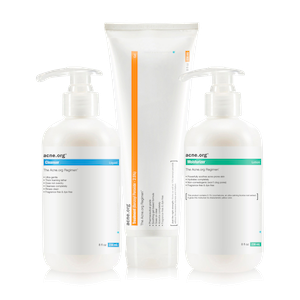 Acne.org Products
Acne.org Products